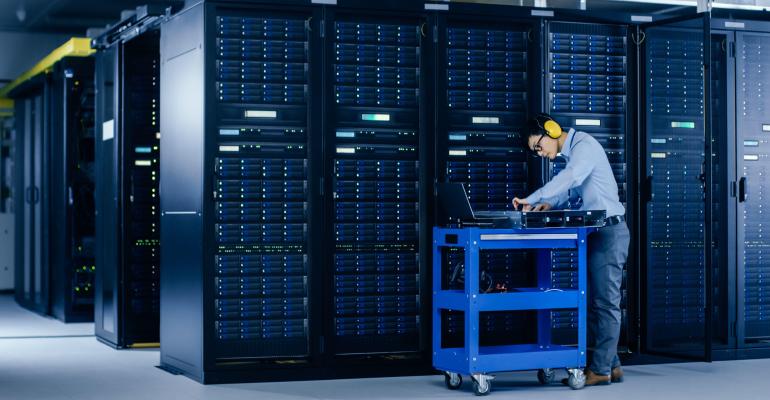
Walter Leclerc is the Director, Environmental Occupational Health and Safety for Digital Realty Trust.
There’s a culture shift afoot in the data center industry. It puts new emphasis placed on safer working conditions for data center engineers and electrical contractors where, historically, such emphasis was a second thought. As equipment has grown increasingly complex and sophisticated, so too have the risks. This new safety awareness is a welcome change.
Today’s data centers -- from the hyper-scale to the agile colocation centers -- have increased in size, complexity and importance. They use massive amounts of power and cooling to ensure reliable operations. Data center companies have come to recognize that safety excellence is imperative to maximize uptime for their customers while reducing operational risk. Of the many safety issues that today’s data center operators must consider, these six rules are at the top of the list. To wit:
- Assess the Risk
- Control Hazardous Energy (CoHE) / Lockout Tagout (LOTO)
- Assure Electrical Safety
- Working at Height
- Hot Work
- Lifting and Handling
Assess the Risk
Workers must assess the risk of any task to be completed before beginning the work. All identified hazards must be addressed prior to starting work by putting in place control measures that eliminate or mitigate the risk. For example, jobs involving high risk work typically require permits. In addition, work in confined spaces or hot work often require the use of personal protective equipment (PPE). It’s a risk control measure, and as such the equipment must be checked for appropriateness and damage prior to each use. To ensure that workers can perform jobs safely, teams must regularly receive specific control measure training. Finally, all jobs must be documented (e.g., method of procedure), which includes a safety risk analysis.
Control of Hazardous Energy
It goes without saying that employees working on any equipment or installation must be trained and competent to do the work safely. Before beginning any task, it is imperative that all energy systems -- electrical, pneumatic, mechanical, hydraulic, chemical, thermal, and others -- are clearly identified. Once the energy systems are identified, workers involved in the job must then agree on the method of isolation by choosing the right lockout device and process to discharge any stored energy. Using this information to know, understand, and document the specific LOTO procedures, workers can properly secure isolation, de-energize the system, and test the system to make sure the isolation is effective before starting work. Many accidents have occurred in data centers because a piece of equipment was improperly de-energized or the wrong isolation point was identified for LOTO and the equipment wasn’t tested. Further, the effectiveness of the isolation needs to be periodically monitored and evaluated during the job. LOTO procedures should also include steps to safely remove the relevant lockout device and re-energize the system upon completion of the job.
Assure Electrical Safety
There are two basic principles of electrical safety: AVOID and PROTECT. Either avoid the electrical hazards or protect against them. But AVOID should always be the preferred approach. Clearances, audits, guarding, and CoHE/LOTO are among the many techniques that comprise the basics of avoiding electrical hazards. If avoiding an electrical hazard is not an option, then using appropriate PPE and other means of protection is the next best approach.
According to NFPA 70E under Article 130, workers must get formal authorization in the form of an energized electrical work permit in most situations before starting “live” electrical work because “live” electrical parts operating at 50 volts or more must be de-energized prior to the start of work. That is, unless the employer can demonstrate that de-energizing introduces additional or increased hazards, or that it isn’t feasible due to equipment design or operational limitations. Exceptions to the rule include:
- Testing of equipment that can only be performed energized
- Working on equipment that is part of a continuous industrial process
- Working on equipment supporting life safety and/or illumination for an area
- Working where de-energizing presents an increased hazard
Once the authorization for “live” electrical work is thoroughly proven and documented (which is to say, it is not possible to de-energize, isolate, CoHE/LOTO, and verify), the following practices to PROTECT must be used:
- Work must be performed by a “qualified person” as defined by OSHA
- All electrical hazards must be identified; a hazard analysis must be completed on all energized sources
- The potential severity of electrical hazards must be reduced wherever possible
- Exposure to electrical hazards must be reduced, including redesigning or modifying the equipment
- Safe and approved electrical work practices, procedures, and tools must be established and put in use to avoid electrical hazards
- When and how much PPE is necessary to mitigate potential hazards must be identified by reviewing arc flash hazard analysis labeling and information, and the company’s safety program
Working at Height
Working at height can be dangerous in a data center. Falling from a roof, a wobbling ladder, or even a drop of just a few inches can cause serious injuries. Accidental falls from heights are one of the biggest causes of data center injuries, so it’s important to do as much work as possible from the ground.
When this is not possible, begin with a risk assessment that identifies all hazards, including but not limited to possible falling objects, before starting the job. Workers must be properly trained to perform work safely at height -- on scaffolds, on scissor lifts, on ladders. Mobile platforms must only be set up, used, and operated by trained workers. Inculcate an awareness of risk. Put appropriate control measures with documented protocols in place prior to starting work at height. For example, make sure workers can get safely to and from where they work at height. Equipment for working at height must be suitable, stable and strong enough for a given job, and regularly and properly checked and maintained. Also, appropriate equipment (platforms, edge protection, and scaffolds) and anchored fall arrest protection (preferably mounted overhead) must be used when required. It is important to visually inspect fall arrest equipment and systems prior to use, and remove any damaged equipment from service. Workers must make sure that they don’t overload or overreach when working at height. Further, it is important to periodically re-evaluate risks during the job and, finally, to thoroughly consider all emergency evacuation and rescue procedures.
Hot Work
To prevent setting fire to a data center, identify the risks and hazards of hot work before starting the job. Hot work fires or explosions occur because of inadequate or poorly implemented hot work management that has allowed ignition sources to come into contact with combustible, ignitable, or flammable material.
The first two rules of hot work safety are AVOID and RELOCATE. Whenever possible, AVOID. Cold work methods eliminate hot work risks. The next best method is to RELOCATE the work to a hot work designated area. If neither option is possible or available, a HOT WORK PERMIT is required for temporary hot work outside a hot work designated area.
Do not start temporary hot work without a properly authorized permit that includes documented measures to control all risks. The area in and surrounding the hot work must be assessed for hazards (e.g., identify explosive atmospheres, dirty floors, cover wall and floor openings), have proper controls are in place (e.g., sprinklers, hose streams, and extinguishers that are in service and operable), and be clear of flammable liquids, dust, lint, oily deposits, and combustible materials prior to the start of any work.
Post the permit at the job and verify that the workers doing the job are competent and properly trained. This is important. Deploy a trained fire watch during hot work and for 60 minutes after work is completed. Follow up with periodic monitoring by a designated fire watch, plant security guard, or engineer for a minimum of three hours after the 60-minute fire watch has stopped.
Lifting and Handling
Before lifting and handling, consider individual capability, the nature of the load, environmental conditions and personal training. Can the load be moved safely alone, or should others assist? Or should lifting equipment be employed, a forklift truck, a hoist or a conveyor? In many data centers, lifts of 50 lbs. (22.7 kg) or more require two or more people, or lifting equipment, to perform the lift safely.
Manual handling in data centers is a high frequency cause of accidents and injuries. If workers need to lift something manually – and this includes pushing, pulling, lifting, lowering, and carrying -- it is important that they:
- Follow correct lifting and handling procedures, including the use of safe footwear, bent knees, straight back, and never over-reaching
- Avoid lifting from floor level or above shoulder height, especially with heavy loads
- Adjust storage areas to minimize the need to perform unsafe movements
- If a load is awkward, try to reduce the carrying distance. Or break the load down into smaller, lighter components. Never carry, push, pull, lower, or lift beyond your limits.
Workers must be trained to use specific lifting equipment. Assign competent trained personnel to rig a load and make certain the load does not exceed the dynamic and/or static capacities of the lifting equipment. Any safety devices installed on lifting equipment must be operational.
Conclusion
Safety considerations and potential hazards in today’s data centers range from confined space entry to hearing protection to industrial hygiene concerns. But from a risk or impact perspective, there are six golden safety rules that typically rate the highest priority for any data center. By putting applicable control measures in place, leading data center operators can proactively implement safety excellence programs to provide their customers as close to 100 percent uptime as possible while protecting the engineers and contractors who keep the data centers running.
Opinions expressed in the article above do not necessarily reflect the opinions of Data Center Knowledge and Informa.
Industry Perspectives is a content channel at Data Center Knowledge highlighting thought leadership in the data center arena. See our guidelines and submission process for information on participating. View previously published Industry Perspectives in our Knowledge Library.





